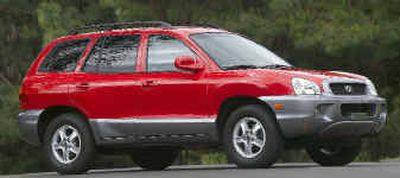More will find their way to Santa Fe

Ninety percent of the battle in the car game is learning what the customers want and providing it at a price they’ll pay.
Credit Hyundai for taking the point.
Back in 2001, the company took some hits when it introduced its Santa Fe mini-ute with too little power and too few amenities.
In truth, no one ever accused a Korean automaker of offering too few amenities — both Hyundai and Kia hang their hats on lengthy standard-features lists — but the original Santa Fe lacked a sunroof, even an optional one.
And neither of its two power plants — the base, 138-horsepower, 2.4-liter four nor the 173-hp, 2.7-liter V-6 — had enough spunk to whip the 3,700-pound Santa Fe into anything resembling a froth.
Arrogance is not the Koreans’ modus operandi. Like the Japanese makers and unlike more than one from Europe, they reckon the people who write the checks should call the shots.
Or so says Finbarr O’Neill, who, despite his shamrock-laced moniker, is president and CEO of Hyundai America.
“Many of the changes our customers suggested are now included in the Santa Fe,” O’Neill said last year, at the introduction of ‘04 Santa Fe. “When Santa Fe buyers told us they wanted a power moonroof, we listened. And now we are offering the Santa Fe 3.5-liter.”
That 3.5-liter is a six-cylinder power plant that makes 195 ponies and 216 pound-feet of torque, enough to push the 3,700-pound SUV around with an acceptable level of zest.
The engine lacks the sophistication of the best of the competition (no variable valve timing, for instance) and fetches mediocre fuel economy numbers. But it’s a serviceable power plant and gets the job done on a budget.
It should come as no surprise that the engine is borrowed from one of Hyundai’s cars, its flagship XG 350.
Stands to reason — the Santa Fe itself is car-based. At its core you’ll find a midsize Sonata. Given that most little ‘utes are based on compacts, this gives the Santa Fe a certain size advantage (among the mini-utes, only Honda’s CR-V rivals the Santa Fe’s dimensions); but as it is in the human sphere, so it is among sport-utes: there’s a direct correlation between size and weight.
At 3,700 pounds, it’s no ballerina; hence, the need for the jumbo six.
It’s standard equipment on the uplevel LX (from $23,999) and optional on the midlevel GLS, which starts at $21,589 when equipped with the 173-hp six and $22,589 with the larger engine.
The base Santa Fe is available with only the four and will come home with you for just $18,589.
All prices are for the front-wheel-drive configured Santa Fe. If you want all four wheels to get in on the fun, you’ll pony up another $800. The base Santa Fe is available only in FWD.
Aside from a few styling quirks that cost it a certain amount of good will (my landlord, who moved it for me one day, complained that the front-fender design makes it nearly impossible to know where the corners are), the Santa Fe is a thoughtfully designed and well-executed light-duty SUV. Like the preponderance of its competitors — they include the CR-V, Toyota RAV4 and the Mazda Tribute/Ford Escape twins — it’s not intended for off-road duty, but instead excels at foul-weather shopping runs and the annual Christmas tree run on a snowy Forest Service road.
As its girth implies, the Santa Fe has a good, solid feel on the road and that sensation of sturdiness is supported by very good crash-test results.
It took a year or two for Hyundai to get around to it, but the Santa Fe now offers side-impact airbags as standard equipment.
That list also includes air conditioning, AM/FM stereo with CD player and six speakers, three power outlets, illuminated and lockable glove box, cargo-area lighting, overhead console, a full-size spare and power windows, mirrors and door locks.
The GLS adds fog lights, a better grade of cloth upholstery and a CD-cassette setup. The LX gets a Monsoon stereo, automatic climate control, leather upholstery, heated seats and an auto-dimming rearview mirror.
That touted moonroof is a $595 option on GLS and LX models; anti-lock brakes with traction control are standard on the LX and optional on the other trims.
The uplevel engine is paired with a new electronic all-wheel-drive system that was engineered to handle the additional torque. In its default mode, it delivers power to the front wheels. Any loss of traction causes an imperceptible transfer of power to the rear wheels.
Implementation of the new system required modifications to the rear suspension, which resulted in improved handling, never one of the Santa Fe’s strong points. The redesign minimizes its tendency to wallow in the corners.
The steering remains somewhat numb, but nobody buys a sport-ute for the privilege of enjoying the sensation of crisp steering with terrific road feel.
So don’t worry about it.
The Santa Fe’s “tweener” proportions allows for the largest cargo capacity in the class. With the 60/40 folding split rear seats in the down position, there is 78 cubic feet of space waiting to be filled.
Now that J.D. Power has proclaimed Hyundai and Kia big winners in its most recent initial-quality survey, more buyers than ever will be turning their eyes to the Koreans. The Santa Fe may not yet be the cream of its particular crop, but with its attractive price and unbeatable warranty, it warrants serious consideration.